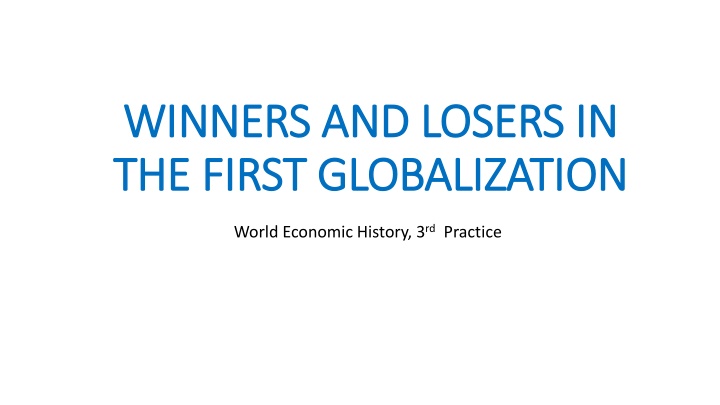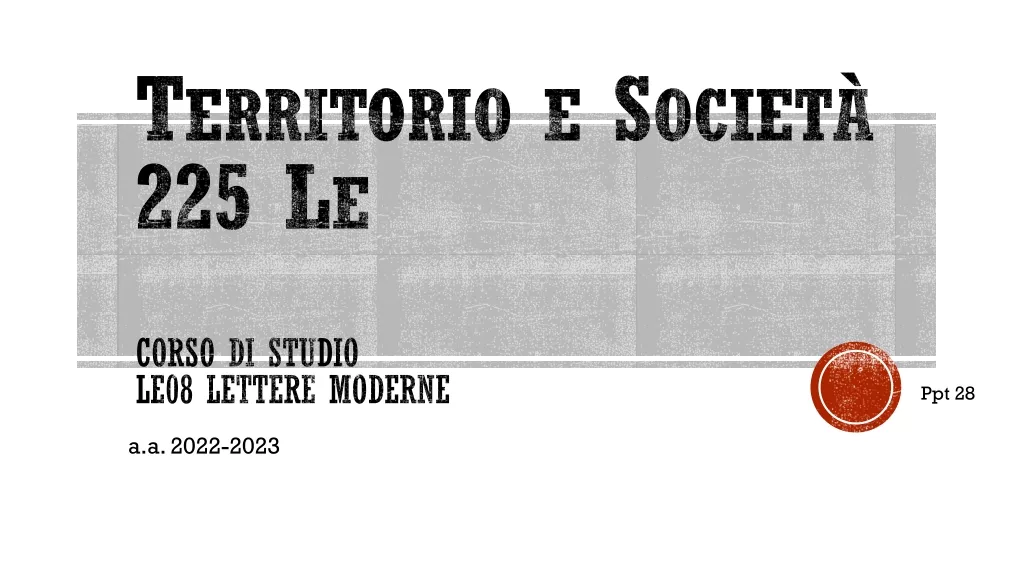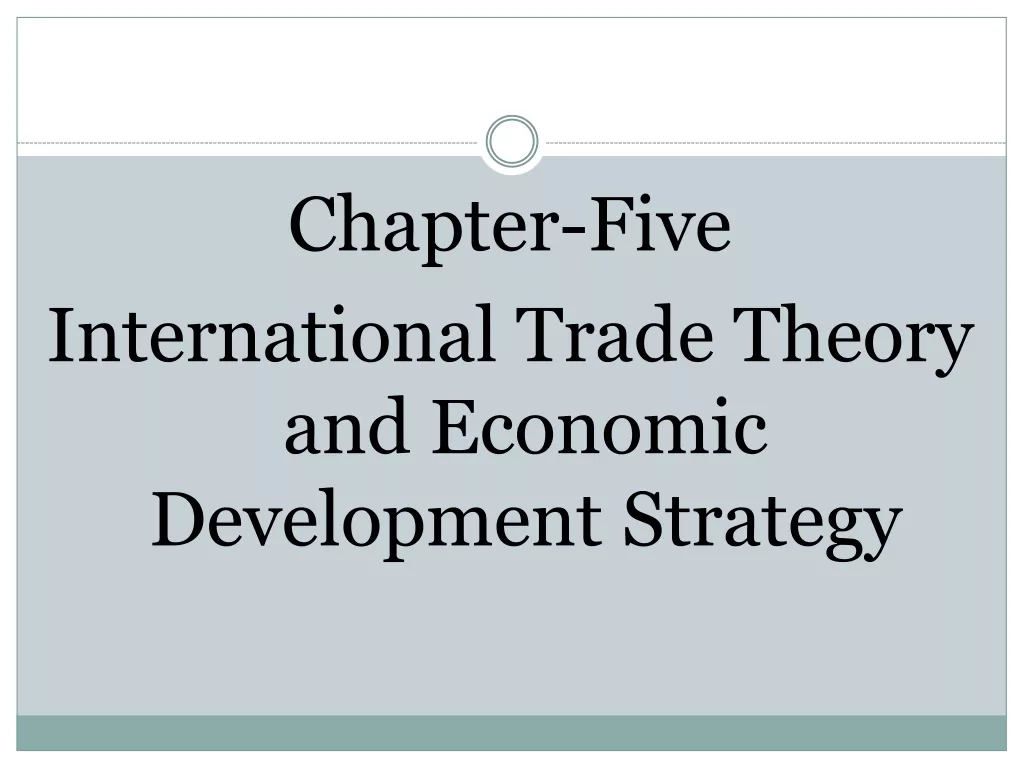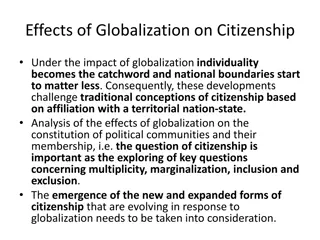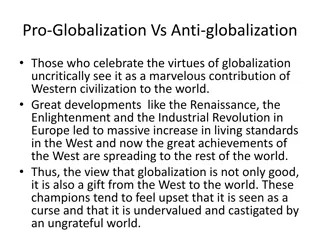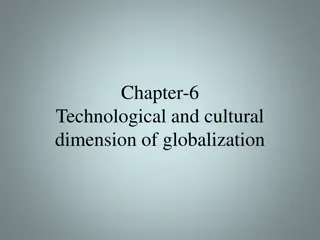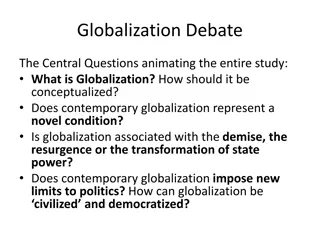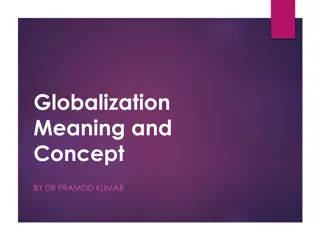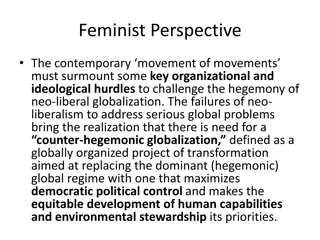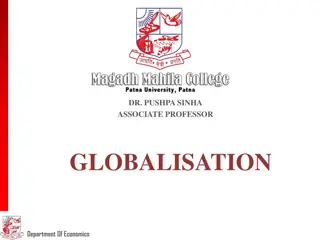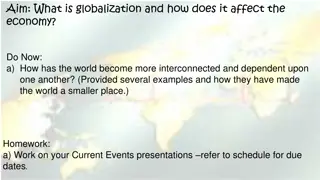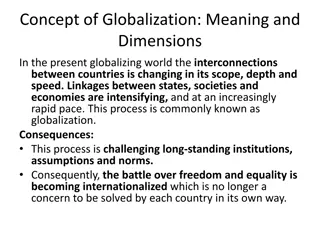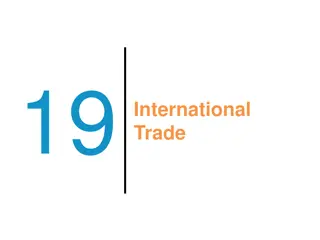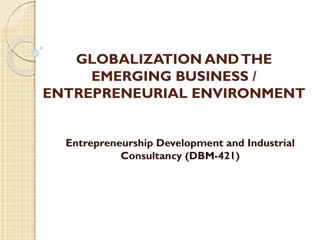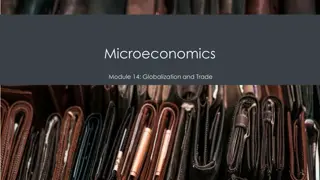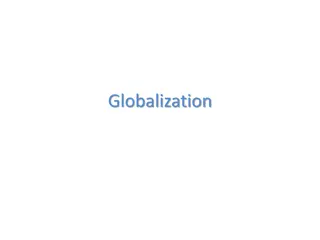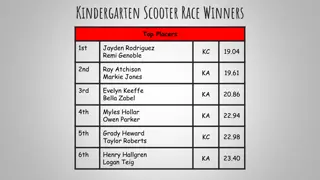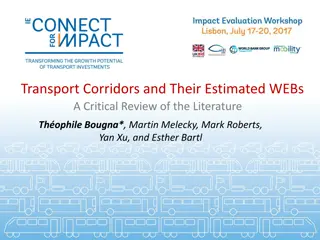Winners and Losers in the First Globalization
The First Globalization led to the rise of wealthier countries while less developed nations faced challenges in international trade, widening the economic gap. The Heckscher-Ohlin model explains the benefits of specialization and trade by focusing on productive factor endowments. Countries leverage comparative advantage to specialize in goods based on their ability to produce at lower costs. Calculating opportunity costs helps determine comparative advantages in trade relationships.
Download Presentation

Please find below an Image/Link to download the presentation.
The content on the website is provided AS IS for your information and personal use only. It may not be sold, licensed, or shared on other websites without obtaining consent from the author.If you encounter any issues during the download, it is possible that the publisher has removed the file from their server.
You are allowed to download the files provided on this website for personal or commercial use, subject to the condition that they are used lawfully. All files are the property of their respective owners.
The content on the website is provided AS IS for your information and personal use only. It may not be sold, licensed, or shared on other websites without obtaining consent from the author.
E N D
Presentation Transcript
WINNERS AND LOSERS IN WINNERS AND LOSERS IN THE FIRST GLOBALIZATION THE FIRST GLOBALIZATION World Economic History, 3rdPractice
The First Globalization played a central role in the ascent of richer countries along the curved part of the "hockey stick". Less developed countries participated in international trade under unfavorable conditions imposed by the metropolis, specializing in sectors that hindered their further development. Thus, the First Globalization consolidated the Great Divergence and increased their distance with the most industrialized countries
HECKSCHER HECKSCHER- -OHLIN MODEL OHLIN MODEL
Why can specialization and trade be economically positive? 1. Differences in productive factor endowments (the weather, abilities, etc.). The HECKSCHER- OHLIN model is based on this. 2. Economies of scale and agglomeration: most international trade happens between countries with similar productive factor endowments. 1. Costa Rica is the biggest pineapple producer in the world thanks to its favourable climitic conditions. 2. Boeing s factory in Seattle (US) is the largest building in the world.
When trade arises due to differences in productive endowments, we use the concept of comparative advantage to determine specialization. Absolute advantage: a person or country has an absolute advantage in the production of a good if it uses less inputs (labor, land, capital) to produce this good than other person or country. Comparative advantage: a person or country has a comparative advantage in the production of a good, if the cost of producing an additional unit of that good relative to the cost of producing another good is lower than another person s or country s. Economists use opportunity costs to determine comparative advantages.
The way we calculate opportunity costs changes a bit depending on the information we are given, but the result is always the same. a) If they tell us the amount of goods X and Y that a unit of a given productive input can produce. Opportunity cost of producing X = ?????? ?? ? ?? ??? ??????? ?????? ?? ? ?? ??? ??????? A worker can produce either 2 apples or 1 tomato. OCTomato = 2/1 = 2 apples OCApple = 1/2 = 1/2 tomato b) If they tell us the amount of a productive input we need to produce a unit of products X and Y. Opportunity cost of producing X = ?????? ???????? ?? ??????? ? ?????? ???????? ?? ??????? ? We need 1 worker to produce a tomato, 0.5 workers to produce an apple. OCTomato = 1/0.5 = 2 apples OCApple = 0.5/1 = 1/2 tomato
Why is international trade often controversial? As people own different productive factors (land, capital, labor, etc.) specialization and trade do not affect everyone equally. 1) Before opening to trade US is capital-abundant wages (w) relative to capital rents (r) are higher in US than in China China is labor-abundant
1) Before opening to trade Planes (P) are intensive in capital and computers (C) are intensive in labor. In US (capital-abundant) planes are cheaper relative to computers than in China. In China (labor-abundant) computers are cheaper relative to planes than in US. What is another way of looking at this? US has to give up less computers than China to build a plane US has a comparative advantage in the production of planes. China has to give up less planes than China to produce a computer China has a comparative advantage in the production of computers.
2) After opening to trade US specializes in planes (capital-intensive) the demand for capital grows quicker than the demand for labor capital rents increase relative to wages. The relative cost of production factor tends to equalize (w/r)USfalls China specializes in computers (labor-intensive) the demand for labor grows quicker than the demand for capital wages increase relative to capital rents. (w/r)CHincreases
2) After opening to trade What happens to inequality within each country? As we have seen, the owners of relatively abundant factors win and the owners of relatively scarce factors lose. In US owners of capital benefit more In China workers benefit more than than workers. owners of capital. (w/r)USfalls (w/r)CHincreases Inequality increases Inequality falls What happens to inequality between countries? As wages are initially higher in US than in China, inequality between countries falls.
FIRST GLOBALIZATION: FIRST GLOBALIZATION: SPECIALIZATION AND INEQUALITY SPECIALIZATION AND INEQUALITY
Between 1850 and 1914 the global economy became more integrated: prices of products and productive inputs converged. There were two key causes: 1. The fall in transportation costs (both between countries and within countries): steamboats, railways, Suez canal 2. The reduction of tariffs due to the influence of liberal thinkers, pressures from export interests and British hegemony.
What did different regions specialize in? We follow the Heckscher-Ohlin model. Great Britain and the rest of Europe were labor-abundant and land-scarce (due to high demographic pressure) wages were low relative to land-rents (w/r was low) They specialized in labor-intensive industrial products. The New World was land-abundant and labor-scarce (frontier economies) wages were high relative to land-rents (w/r was high) They specialized in land-intensive agricultural products.
What was the distributive impact of these patterns of specialization? Great Britain and other European countries specialized in labor-intensive industrial products (w/r)E Demand for labor increased relative to demand for land Wages increased relative to land-rents Industrial workers benefited more than landowners Inequality fell.
What was the distributive impact of these patterns of specialization? The New World specialized in land- intensive agricultural products (w/r)NW Demand for land increased relative to demand for labor Land-rents increased relative to wages Landowners benefited more than workers (specially low-skilled workers) Inequality increased.
FIRST GLOBALIZATION: FIRST GLOBALIZATION: THE IMPACT OF MIGRATION THE IMPACT OF MIGRATION
Between 1820 and 1914, about 60 million Europeans migrated to the New World. What caused these migration flows? 1. Above all, economic reasons: the search for higher wages and employment opportunities. In Europe, demographic pressures and migration to cities limited employment and wages. The New World, abundant in natural resources and labor-scarce, had higher wages and more employment opportunities. 2. Falling transportation costs, access to credit and the opportunity to accumulate savings (the poorest, or the inhabitants of the poorest regions, could not afford the trip overseas). 3. Migratory chains: friends and relatives who had migrated earlier sent remittances to finance the trip and provided support in the countries of destination.
Immigrants in Ellis Island (New York) c. 1900 (Photo: Bettman/Corbis)
Between 1820 and 1914, about 60 million Europeans migrated to the New World. What were the consequences of these migration flows? In Europe labor outflows reduced demographic pressures and increased employment opportunities, pushing up wages. In the New World This limited wage growth, specially in low-skilled activities. the massive influx of migrants increased the supply of labor. This counteracted or reinforced the impact of trade? Migratory flows reinforced the distributive effects of trade: (w/r)E : inequality falls (w/r)NW : inequality increases
In short, between 1850 and 1914 (i) international trade and (ii) migratory flows led to a process of convergence in the relative prices of productive factors and in the living standards of the richer economies. )NW (? ? )E (? ?
THE REACTION AGAINST THE REACTION AGAINST GLOBALIZATION GLOBALIZATION
Globalization did not benefit all population segments and those who emerged as losers claimed for governments to reverse economic integration. The success of these revindications depended on the political weight of affected sectors. What happened in Europe? Big landowners were the main losers from trade, as cheap grain imports from the New World and Russia reduced land-rents. Additionally, their industry was not as competitive as British manufactures countries like Germany, France and Spain raised tariffs. In these countries, convergence with the New World and inequality reduction stopped.
What happened in the New World? Immigrants increased competition for low-skill jobs, limiting wage growth New World countries took measures to slow the arrival of foreign workers. In short, the rise of inequality and the political power of those who emerged as losers led some countries to adopt protectionist measures in the interwar period, especially after the Great Depression, international markets disintegrated. History shows that globalization can plant the seeds of its own destruction. (O Rourke & Williamson, 1999)
CORRECTION CORRECTION
1. England and Portugal need these workers to produce a given amount of wine and cloth. Determine absolute advantages and comparative advantages. Cloth Wine Portugal has absolute advantage in the production of both cloth and wine (it needs less workers to produce both products) England 100 120 Portugal 90 80 Portugal England England has a comparative advantage in the production of cloth (the OC of producing cloth is lower than Portugal s) OCCLOTH = OCCLOTH = 100/120 = 0,833 90/80 = 1,125 Portugal has a comparative advantage in the production of wine (the OC of producing wine is lower tan England s) 80/90 = 0,889 OCWINE = 120/100 = 1,2 OCWINE = Economists use the concept of opportunity costs to determine comparative advantages. Opportunity Cost of producing X= (inputs required to produce X) / (inputs required to produce Y)
2. What will Canada specialize at? Why? What will Vietnam specialize at? Why? -Canada specializes in robots. Canada is abundant in skilled workers, and robots are intensive in skilled-labor. -Vietnam specializes in t-shirts. Vietnam is abundant in unskilled workers, and t-shirts are intensive in non- skilled labor. Before opening to trade, the wage of a skilled worker in Canada is 2 times the wage of an unskilled worker. After specializing and exporting part of its production, this ratio will rise or fall? Why? Initially: ?? ???= ? (Ws = wage of skilled workers, Wns = wage of non-skilled workers) After specializing in robots, the ratio in Canada increases. (Specialization in robots, intensive in skilled-labor, increases the demand for skilled workers the wage of skilled workers increases). Before opening to trade, the wage of a skilled worker in Vietnam is 8 times the wage of an unskilled worker. After specializing and exporting part of its production, this ratio will rise or fall? Why? Initially: ?? ???= ?. After specializing in t-shirts, the ratio in Vietnam falls. (Specialization in t-shirts, intensive in non-skilled-labor, increases the demand for non-skilled workers the wage of non-skilled workers increases).
Ultimately, who will benefit more from trade in Canada? And in Vietnam? -In Canada skilled-workers benefit more. -In Vietnam unskilled-workers benefit more. -In both cases, and in line with the predictions of the Heckscher-Ohlin model, the owners of the abundant factor win. What will happen with inequality in Canada? And in Vietnam? Wage inequality is determined by the ratio ?? ???(Ws = wage of skilled workers, Wns = wage of non-skilled workers). The higher this ratio, the higher the wage gap between skilled and unskilled workers (i.e. inequality is higher). Thus, in our example: In Canada ?? ??? : inequality rises. In Vietnam ?? ??? : inequality falls.
3. In each graph, write 3 countries whose wage-land rent ratio (w/r) followed that pattern between 1870 and 1915. European countries that kept free trade: Great Britain, Denmark, Ireland, Sweden. New World countries: Argentina, Canada, US, Australia. European countries that resorted to protectionism: Germany, France, Spain.
4. Assume wages (w) are higher relative to land-rents (r) in Argentina than in Great Britain. We obtain: ? ?ARG > ? ?GB a) With this information, we know that land-rents are higher in Great Britain than in Argentina. Not necessarily. If land-rents are higher in Argentina than in Great Britain, the relation above can still hold if wages in Argentina are sufficiently higher than in Great Britain. b) If land-rents rise in Great Britain, the relation above could be no longer true. No, because (w/r)GBwould be even lower. c) If wages are lower in Argentina than in Great Britain, land-rents must necessarily be higher in Great Britain for the relation to hold. Landowners are richer than workers. Therefore, if (w/r) is higher, wages are higher relative to land-rents d) Inequality is lower in Argentina than in Great Britain. inequality is lower. e) If Argentina specializes in the production of land-intensive agricultural products, its inequality will decrease. No, because land-rents would grow relative to wages. f) If a million Argentinians migrate to Great Britain looking for work, the relation above could be no longer true. No. This reinforces the relation: wages rise in Argentina and fall in Great Britain. g) For relative prices in Argentina and Great Britain to equalize, Argentinian wages must fall. Not necessarily. Relative prices can equalize if Argentinian wages fall, but also if land-rents in Argentina rise, if wages in Great Britain rise or if land-rents in Great Britain fall.
